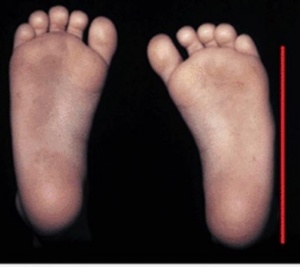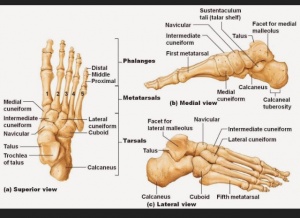Metatarsus Adductus
Original Editor - Shaniel Walters
Description[edit | edit source]
Metatarsus Adductus ( Hooked Foot)[edit | edit source]
Common foot deformity seen in children which causes the foot to turn inwards. The foot appears "c-shaped. This condition is often associated with hip dysplasia.
Types[edit | edit source]
Metatarsus Adductus may be classified as:
Flexible: Presents with adduction of the 5 metatarsal bones at the tarsometatarsal joint.
Rigid: Presents with medial subluxation of the tarsometatarsal joints. There is valgus of the hindfoot and the navicular is later to the head of the talus.
Clinically Relevant Anatomy
[edit | edit source]
The skeleton of the foot is made of the thirty three bones, twenty six six joints and over a hundred muscles, ligaments and tendon. The foot serves primarily as a weight-bearing joint and provides a stable base of support on which to stand. Ligaments are attached to the bones which creates joints. The anatomy of the foot is divided into 3 categories: the Forefoot, the Midfoot and the Hindfoot.
Hindfoot is comprised of : Tibiofibular joint , Talocular joint and the Subtalar (Talocalcanean) joint.[1 1]
Midfoot (Midtarsal Joints) is comprised of: Talocalcaneonavicular Joint, Cuneonavicular Joint, Cuboideonavicular Joint, Intercuneuform Joints, Cuneocuboid joint and the Calcaneocuboid Joint.[1 1]
Forefoot is comprised of: Tarsometatarsal Jointts, Intermaetatarsal Joint, Metatarsophalangeal Joints and Interphalangeal Joints.[1 1]
Epidemiology and Etiology[edit | edit source]
There is an incidence of 1 in 100 to 1 in 5,000 live births.[2 1] The cause of metatarsus adductus remains unknown. It is however, thought to be related to intrauterine compression. Family history may also be a causative factor. Other theoriespof causal relation includes abnormal tendon insertion of tibialis anterior, tibialis posterior and abductor hallucis muscles.[3 1]
Clinical Presentation[edit | edit source]
The forefoot is adducted and sometimes supinated , but the midfoot and hindfoot are normal. There is convexity of the lateral border of the foot, with concavity of the medial border. Older children may present with an in-toeing gait.
Diagnostic Procedures[edit | edit source]
add text here relating to diagnostic tests for the condition
Management / Interventions
[edit | edit source]
Specific treatment for metatarsus adductus is often determined by the following factors:
- Child's Age
- Medical History
- Extent of the condition
- Tolerance for the specific procedure
- Expectations for the condition
Interventions include:[edit | edit source]
- Passive Stretching
- Passive Manipulation exercises
- Stretching
- Serial Casting
- Footwear
- Surgery to release the joints
Prognosis[edit | edit source]
Generally excellent. Most cases of metatarsus adductus often resolves on its own
References[edit | edit source]
Cite error: <ref> tags exist for a group named "1", but no corresponding <references group="1"/> tag was found
Cite error: <ref> tags exist for a group named "2", but no corresponding <references group="2"/> tag was found
Cite error: <ref> tags exist for a group named "3", but no corresponding <references group="3"/> tag was found








